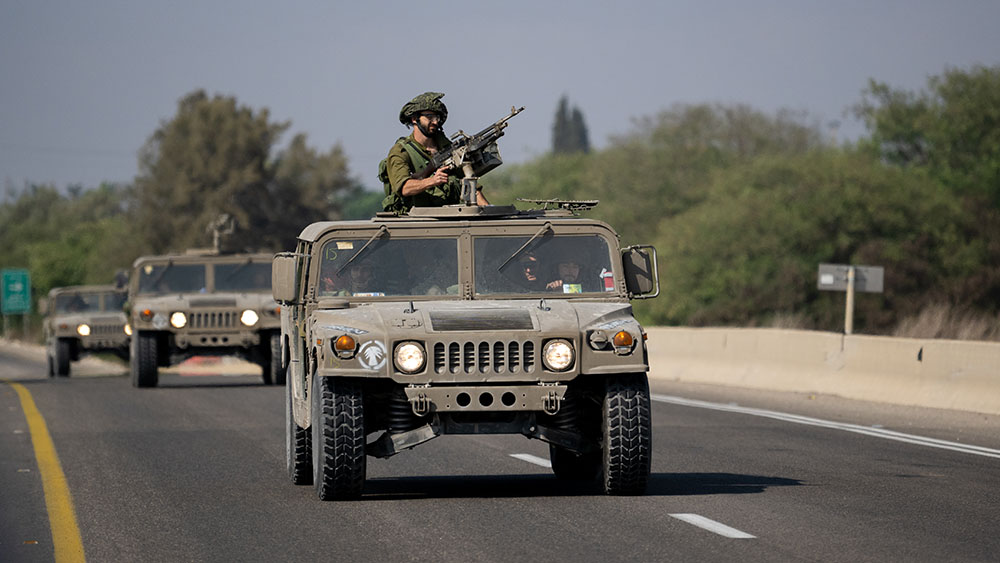Chinese woman evades warrant for vehicular manslaughter after horror wreck caught on camera A Chinese woman fled back to her homeland after allegedly killing her [more…]
20 Essential steps for preppers to start the New Year prepared
(NaturalNews) Ensure all household members know evacuation routes, communication methods and shelter-in-place procedures based on local risks. Rotate food, w…
The future of personalized nutrition: How AI and microbiome science could revolutionize dietary guidance
(NaturalNews) Researchers used genetic sequencing and AI-driven software (Terapia Alimentare Dietosystem) to analyze gut microbiomes and recommend dietary adjus…
“Regenerate Yourself Masterclass” on BrightU: Sayer Ji explains how your brain and heart can heal
(NaturalNews) On Day 2 of “Regenerate Yourself Masterclass,” aired on Dec. 14, Sayer Ji challenged the conventional medical model of the body as a machine, adv…
British Parliament rejects call to roll back Online Safety Act
(NaturalNews) The British Parliament debated repealing the Online Safety Act (OSA) after a 160,000-signature petition but rejected calls to roll it back, instea…
EU’s seizure of Russian assets sparks legal showdown as Moscow demands $230 billion
(NaturalNews) The EU is considering repurposing â¬200 billion ($234 billion) in frozen Russian sovereign assets to fund Ukraine, escalating tensions. Russia ha…
Escape the Surveillance State: A wake-up call for the digital age
(NaturalNews) The book exposes the modern surveillance apparatus (cameras, smartphones, AI tracking) and traces its roots to Cold War-era spy programs like ECHE…
UN watchdog warns Chernobyl shield breached, urgent repairs needed after wartime damage
(NaturalNews) A Russian drone strike has severely damaged Chernobyl’s protective containment dome. The breach has compromised the structure’s primary safety …
Canadian intelligence officer caught sharing state secrets with Ukraine: Is NATO plotting false flags to expand war against Russia?
(NaturalNews) The North Atlantic Treaty Organization, an alliance founded on collective defense, now finds its own members compromised by the very proxy forces it a…
Affordability crisis grips Canada and U.S. as polls show overwhelming public distress over rising prices
(NaturalNews) A new poll shows most Canadians feel the current cost of living is the worst they’ve ever experienced. Food prices are the primary and most uni…
Syrian Alien Pulls Out AK-47 Rifle After Being Rejected From Leipzig Nightclub
Video shows the Syrian man being tackled by security staff after pulling out an AK-47 rifle.
Nearly 40% Of Women Suffer Severe Grief For Years After Abortion, Miscarriage: Study
39% of women with pregnancy loss, including abortion, report that ‘the worst of their negative feelings persist an average of 20 years’ afterward, including nightmares [more…]
72-Year-Old Woman Assaulted, Raped & Robbed In Her French Apartment After Simply Trying To Close The Window
The police have already collected the suspect’s DNA after he raped her with penetration.
This is what ‘abolish America’ looks like in practice
Federal prosecutors in Los Angeles announced that four members of an anti-capitalist extremist group were arrested on Friday for plotting coordinated bombings in California on New Year’s Eve.
According to the Department of Justice, the suspects planned to detonate explosives concealed in backpacks at various businesses while also targeting ICE agents and vehicles. The attacks were supposed to coincide with midnight celebrations.
Marxists, anarchists, and Islamist movements share a conviction that the United States, like Israel, is a colonial project that must be destroyed.
The plot was disrupted before any lives were lost. The group behind the plot calls itself the Turtle Island Liberation Front. That name matters more than you might think.
When ideology turns operational
For years, the media has told us that radical, violent rhetoric on the left is mostly symbolic. They explained away the angry slogans, destructive language, and calls for “liberation” as performance or hyperbole.
Bombs are not metaphors, however.
Once explosives enter the picture, framing the issue as harmless expression becomes much more difficult. What makes this case different is the ideological ecosystem behind it.
The Turtle Island Liberation Front was not a single-issue group. It was anti-American, anti-capitalist, and explicitly revolutionary. Its members viewed the United States as an illegitimate occupying force rather than a sovereign nation. America, in their view, is not a nation, not a country; it is a structure that must be dismantled at any cost.
What ‘Turtle Island’ really means
“Turtle Island” is not an innocent cultural reference. In modern activist usage, it is shorthand for the claim that the United States has no moral or legal right to exist. It reframes the country as stolen land, permanently occupied by an illegitimate society.
Once people accept that premise, the use of violence against their perceived enemies becomes not only permissible, but virtuous. That framing is not unique to one movement. It appears again and again across radical networks that otherwise disagree on nearly everything.
Marxists, anarchists, and Islamist movements do not share the same vision for the future. They do not even trust one another. But they share a conviction that the United States, like Israel, is a colonial project that must be destroyed. The alignment of radical, hostile ideologies is anything but a coincidence.
The red-green alliance
For decades, analysts have warned about what is often called the red-green alliance: the convergence of far-left revolutionary politics with Islamist movements. The alliance is not based on shared values, but on shared enemies. Capitalism, national sovereignty, Western culture, and constitutional government all fall into that category.
History has shown us how this process works. Revolutionary coalitions form to tear down an existing order, promising liberation and justice. Once power is seized, the alliance fractures, and the most ruthless faction takes control.
Iran’s 1979 revolution followed this exact pattern. Leftist revolutionaries helped topple the shah. Within a few years, tens of thousands of them were imprisoned, executed, or “disappeared” by the Islamist regime they helped install. Those who do not understand history, the saying goes, are doomed to repeat it.
RELATED: The right must choose: Fight the real war, or cosplay revolution online
Aaron Schwartz/Bloomberg via Getty Images
This moment is different
What happened in California was not a foreign conflict bleeding into the United States or a solitary extremist acting on impulse. It was an organized domestic group, steeped in ideological narratives long validated by universities, activist networks, and the media.
The language that once circulated on campuses and social media is now appearing in criminal indictments. “Liberation” has become a justification for explosives. “Resistance” has become a plan with a date and a time. When groups openly call for the destruction of the United States and then prepare bombs to make it happen, the country has entered a new phase. Pretending things have not gotten worse, that we have not crossed a line as a country, is reckless denial.
Every movement like this depends on confusion. Its supporters insist that calls for America’s destruction are symbolic, even as they stockpile weapons. They denounce violence while preparing for it. They cloak criminal intent in the language of justice and morality. That ambiguity is not accidental. It is deliberate.
The California plot should end the debate over whether these red-green alliances exist. They do. The only question left is whether the country will recognize the pattern before more plots advance farther — and succeed.
This is not about one group, one ideology, or one arrest. It is about a growing coalition that has moved past rhetoric and into action. History leaves no doubt where that path leads. The only uncertainty is whether Americans will step in and stop it.
San diego, Planned terror attack, Radical left, Marxists, Radical islam, Terrorism, Opinion & analysis, Turtle island liberation front, New year’s eve, Fbi
The UK’s Plan To Put An Age Verification Chaperone In Every Pocket
A nation’s surveilling guardrail threatens to become its digital leash.
Officer Tatum & Other Investigators Believe A Potential Suspect In The Brown University Attack Is Being Protected, And That An Ongoing Cover-Up Is Taking Place
Infowars reached out to Brown University, and has received a statement that is covered in this report.
Growing up in the Hebrew Roots movement — and why I eventually had to leave
Several years before my husband and I met, one of his friends told him, “Modern youth are hungry for truth, and they are looking to the oldest forms of traditional orthodoxy to find it. This leaves them with two main choices: Catholicism or Hebrew Roots.”
My husband hadn’t heard of Messianics before this, or he had heard just enough to scoff at the idea of marrying someone who “pretended to be a Jew.” Nevertheless, his friend’s statement stuck with him. Who were these Protestants LARPing as Jews that they could draw intelligent youth in search of truth away from Catholicism?
We were all encouraged to study our Bibles for ourselves and to test one another. When the family home-churched together, it was always lively.
Relishing the chaos
Some would call us Judaizers.
We are certainly not ordinary Protestants. In fact, my family and most Messianics I grew up with believed that the Catholic Church is the whore of Babylon and the Protestant churches are her daughters. Most Christians were “too Catholic” in our opinion because they went to church on Sunday and celebrated Christmas, two practices instituted by Catholicism.
Despite how odd Messianics might be, they are too disorganized to be classified as a cult. There are somewhere around 200,000-300,000 Hebrew Roots people with no central figure, and there are countless groups within the movement. Some of them are self-identifying Torah followers who may lead isolated lives or fellowship at home with a few like-minded people. Others are members of organized Messianic denominations.
The movement has very few real Jews in it, and for the most part Messianic believers reject modern-day Jewish practices. Instead we endeavor to interpret the Old Testament as literally as possible. This, of course, is nearly an impossible feat and the main cause for disunity in the Hebrew Roots movement.
Perhaps what makes this expression of group interesting is the fact that it is a movement that can’t really be defined as a whole, and yet all the members of it believe that the truth they have is absolute, even though all their like-minded compatriots disagree with them on how to execute this truth. To those raised in the movement, the disorder and chaos are natural and even relished. To those watching from the outside, I can only imagine how bizarre we appear.
Family tradition
My mom chose my name because it was old-fashioned. Most of the rest of the family didn’t like it and tried to give me various nicknames. But my parents named me perfectly.
Keturah — meaning a sacrificial aroma/incense — may be strange-sounding, but it also uniquely fits in all the worlds I’m most interested in. It is both a Jewish and an Amish name and, oddly, has a deep Catholic meaning. It has served me well in the secular world, too, with its unique sound. My name has made it possible for me to blend in among both Christian hippies and woke misfits.
I never considered how odd it was that my great-grandfather basically invented the religion I grew up with (with heavy modifications made by my grandfather). What should have been a red flag — why did nobody figure this out before my great-grandfather? — was instead championed as proof of our righteousness.
My great-grandfather had been a Pentecostal pastor. But he started reading his Bible one day. This led him to preaching on things that his congregation was not ready for, because “the ways of the world were too comfortable.” He left his church, took another wife (his first wife left him with their three children because his beliefs were getting strange), and began a road ministry that my grandfather eventually took over.
I was often told the story of the Rechabites, a family who were saved from being utterly wiped out because they obeyed the words of their great-grandfather. My great-grandfather, too, had left us an inheritance, and if we cherished it, we would be saved from the horrors of the world. I believed this.
RELATED: Deliverance requires memory — and America is forgetting
Photo by Heritage Images/Getty Images
Lively debate
I was neither brainwashed nor raised in a cult. There is nothing more American than leaving the beaten path to make your own way, especially when it comes to religion.
The women in my family are too mouthy and bratty, myself included, for the family to ever have fallen into true patriarchal suppression. We were all encouraged to study our Bibles for ourselves and to test one another. When the family home-churched together, it was always lively.
Even I, at the ages of 10 through 14, would get pulled into the heated dialogue with religious opinions of my own, carefully researched and passionately presented. I was obsessed with writing theological essays during those years.
We were not cosplaying as Jews any more than Amish are LARPing as peasants. We were more interested in what the Bible had to say than the traditions of modern-day Jews. In fact, anything that was “traditional” must be too much like Catholicism. We didn’t want to follow customs, but the law of Yahweh.
Although my great-grandfather and grandfather invented our faith, there was room for fluidity. It has changed much over the years. My great-grandfather kept the Saturday Sabbath and refused welfare for his family although they were poor and had 13 children. They did not eat pork, but ate according to Leviticus 11. We call this eating kosher, but it’s more accurately referred to as eating “clean.”
My grandfather started using the “Sacred Names” to refer to God when my father was young and warned against “calling upon the name of Jesus” because Jesus, he argued, was another form of Zeus. We argued over whether to spell the Messiah’s name Yahshua or Yeshua. We never referred to God as “God” or “the Lord” because those, too, were pagan names. It was always “Father” or “Yahweh.”
Which Sabbath?
When I was 9 years old, my grandfather realized that Saturday was not the true Sabbath. He had discovered an idea called the Lunar Sabbath.
The Sabbath is determined by the phases of the moon. At the end of the month when the moon goes dark, the Sabbath is two or three days long until the new moon appears and resets the Sabbath. And so Sabbath might be on a Tuesday one month and then Wednesday or Thursday the next month. If it were cloudy, it might be difficult to see the moon, and sometimes we would be keeping Sabbath wrong for a week or so until we were able to clearly see what the sky said. It was also difficult for making plans and having social relationships.
When I was 14, I sat down and did a long study on the Sabbath using encyclopedias, various Bibles, and concordances. After three months I presented my research to my family. I explained the pros and cons for the Lunar Sabbath, Saturday Sabbath, and Sunday Sabbath. I had become convinced that Sunday was still not the true Sabbath and that we should stop doing the Lunar Sabbath and revert to Saturday. My parents and siblings could not argue with my evidence. We voted. After five years of living by the moon, we unanimously agreed to revert back to Saturday Sabbath.
This situation taught me several things: We were not a cult, but most of my family was intellectually incapable of interpreting scripture for themselves. It was cool that my family changed after my research. But also why hadn’t they studied this properly at the start? I was 14 years old, and yet I had convinced my parents to make a major theological change. This both inflated my ego and left me feeling insecure and unstable because I was truly alone and could not go to my parents for answers about God.
This is part one of a two-part essay. Part 2 will appear next week. It was adapted and edited for length from an essay that first appeared on the Substack Polite Company.
Faith, Abide, Christianity, Sects, Protestantism, Catholicism, Lifestyle, Church-hopping, Culture, Judaizers, Messianic jew, Messianics, Hebrew roots
Trump takes a wrecking ball to the woke campus economy
To the far-left loons and anti-American activists who dominate large swaths of the nation’s four-year college campuses, a reminder: Donald Trump is your president. And whether you like it or not, he now functions as your college dean.
The title may be unofficial, and no one expects Trump to hand out diplomas, but the reality is unavoidable. Through executive orders and funding decisions, Trump is now calling the shots in higher education. His administration is dismantling a long list of Obama-Biden-era policies that entrenched DEI bureaucracies, racial discrimination, radical gender ideology, and other woke orthodoxies that turned college campuses into centers of political indoctrination rather than education.
Faculty lounges and administrative offices dominated by liberal orthodoxy have failed students for too long.
Trump, alongside Education Secretary Linda McMahon, is not only shrinking the Department of Education’s bureaucratic footprint but demanding that universities deliver measurable value to students. For the first time in years, outcomes matter again.
End this discriminatory rule
That shift should become unmistakable this month, when the Department of Education launches the Accountability in Higher Education and Access through Demand-driven Workforce Pell Committee negotiated rulemaking. Trump’s One Big Beautiful Bill Act directs the department to establish new accountability measures tied directly to student outcomes, including a uniform earnings premium standard for all colleges and universities.
This reform creates an opportunity to finally eliminate the Gainful Employment Rule, a discriminatory relic of the Obama and Biden administrations’ radical education agenda. Under Trump’s approach, earnings standards would apply across the board, regardless of an institution’s tax status or curriculum.
The goal is straightforward: Colleges should prepare students for productive careers. Programs will be evaluated by comparing graduates’ median earnings to those of working adults with only a high-school diploma — or, in the case of graduate programs, a bachelor’s degree. Programs whose graduates fail to outperform those benchmarks for two out of three years would lose access to federal student aid.
That standard exposes the true purpose of the GER under Democrat administrations. It was never about protecting students. It was about punishing institutions disfavored by the academic establishment — especially career colleges and faith-based schools — while shielding traditional four-year universities from scrutiny.
Biden’s war on for-profit schools
Obama and Biden applied the GER almost exclusively to proprietary schools, even though public and nonprofit universities enroll the vast majority of students. A Wall Street Journal analysis found that if the Biden administration’s debt-to-earnings metrics were applied evenly, nearly 80% of failing programs would be housed at public and nonprofit institutions.
The left sees no problem saddling students with six-figure debt for degrees in fashionable but economically useless fields. But students training to become construction managers, electricians, or caterers must be “protected” from choice — even though they typically graduate with far less debt and far better job prospects.
Selective enforcement reveals the real agenda. By targeting career colleges while exempting elite institutions, Democrat administrations sought to limit educational choice and justify mass student loan forgiveness. The system was designed to funnel students into four-year degree programs regardless of whether those programs matched their skills, interests, or career goals.
RELATED: Christian students are pushing back — and universities are cracking
Kent Nishimura/Bloomberg via Getty Images
Reversing the damage
It is no coincidence that public confidence in higher education collapsed during this same period. By 2023, a majority of Americans said a four-year degree was no longer worth the cost. Only about 30% of recent graduates found entry-level jobs in their field of study, and roughly two-thirds of Gen Z graduates say they would reconsider attending college if given the chance.
The AHEAD committee now has an opportunity to reverse that damage. By repealing the Gainful Employment Rule and implementing a single, fair accountability standard, it can restore value to higher education and respect the diversity of educational paths students choose.
Higher education should foster intellectual growth, opportunity, and freedom — not ideological conformity or lifelong debt. Faculty lounges and administrative offices dominated by liberal orthodoxy have failed students for too long. Americans should welcome a president who not only recognizes the problem but is finally doing something about it.
Opinion & analysis, Donald trump, Linda mcmahon, Education department, Higher education, Ahead, Gainful employment, Regulations, Wall street journal, Colleges and universities, Jobs, Profit
Trump White House trolls Obama, Biden with new plaques in Presidential Walk of Fame
The Trump administration has made another addition to its many makeovers of the White House, this time poking fun at some of President Donald Trump’s predecessors.
On Wednesday, the White House added biographical plaques under the portraits of the Presidential Walk of Fame along the colonnade of the West Wing.
‘Sleepy Joe Biden was, by far, the worst President in American History.’
Each president’s portrait is now accompanied by a plaque detailing the achievements and mishaps of their presidency. However, two former presidents, Barack Obama and Joe Biden, were given special treatment with an extra plaque detailing some of the lowlights during their tenure in office.
RELATED: Hilarious White House video trolling Biden at Presidential Walk of Fame goes viral online
Photo by Brendan Smialowski / AFP via Getty Images
Obama’s first plaque reads: “Barack Hussein Obama was the first Black President, a community organizer, one term Senator from Illinois, and one of the most divisive political figures in American History. As President, he passed the highly ineffective ‘Unaffordable’ Care Act, resulting in his party losing control of both Houses of Congress, and the Election of the largest House Republican majority since 1946. He presided over a stagnant Economy, approved the terrible Iran Nuclear Deal, and signed the one-sided Paris Climate Accords, both of which were later terminated by President Donald J. Trump.”
Obama’s second plaque details many of his foreign and domestic failures and concludes, “His handpicked successor, Hillary Rodham Clinton, would then lose the Presidency to Donald J. Trump.”
Biden, whose portrait was replaced with a photo of an autopen in reference to the autopen scandal of his presidency, fared no better: “Sleepy Joe Biden was, by far, the worst President in American History. Taking office as a result of the most corrupt Election ever seen in the United States, Biden oversaw a series of unprecedented disasters that brought our Nation to the brink of destruction.”
The second plaque notes that Biden was both “Sleepy” and “Crooked” and concludes: “Biden weaponized Law Enforcement against his political opponent, while also persecuting many other innocent people. He left office issuing blanket pardons to Radical Democrat criminals and thugs, as well as members of the Biden Crime Family — But despite it all, President Trump would get Re-Elected in a Landslide, and SAVE AMERICA!”
Like Blaze News? Bypass the censors, sign up for our newsletters, and get stories like this direct to your inbox. Sign up here!
Politics, President donald trump, Walk of fame, West wing, President joe biden, Barack hussein obama, President obama, Sleepy joe
Study reveals bats have an internal “compass” that functions independent of celestial cues
(NaturalNews) Researchers recorded neural activity in bats navigating in the wild, revealing a sophisticated internal “compass” that functions independently of …
ADHD medications linked to increased glaucoma risk, reports study
(NaturalNews) A Canadian study found that the use of common ADHD drugs (methylphenidate, amphetamines, atomoxetine) increase the risk of both angle-closure (ACG…



























